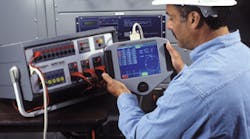Electronic relays have evolved a lot since their introduction in the early '30s, but their basic purpose hasn't changed. Transistors and integrated circuits have replaced vacuum tubes and the term “solid-state” has even taken the place of “electronic,” but the relays are still used to duplicate and replace electromechanical components with more reliable and accurate electronic circuits. And as the technology has improved, the number of applications for their use has even increased. However, even though solid-state relays are the preferred choice for protecting electrical systems, they present their own unique problems that make it necessary to take additional precautions when testing, adjusting, or repairing them.
Why solid-state? Solid-state relays are less affected by dirt, vibration, humidity, and the other environmental concerns. And because they have fewer moving parts, they require less maintenance and are less likely to fail at critical times.
These devices are also much more sophisticated than their predecessors. More complex protection systems can be contained in relatively small packages with solid-state relays, resulting in increased levels of protection for the power system as well as reduced space requirements for housing the relay(s).
Adjustments on solid-state relays are normally made using potentiometers, variable capacitors, or variable inductors. These components allow for both easier and more accurate adjustments then required for electromechanical relays, which have spring tensions, permanent magnet settings, or air gaps.
But as good as all this sounds, solid-state relays aren't without faults. In particular they're inherently sensitive to voltage spikes and surges. This means you must use the appropriate support equipment to prevent surges from reaching the relays. Such equipment includes, but is not limited to, rubber mats, grounded test benches, and carefully regulated test supplies.
Effects on testing. These advantages and disadvantages have lead to several modifications in the way the testing is performed on solid-state relays, including the following:
No insulation resistance. Applying DC voltages (500V or higher) to solid-state circuits isn't recommended. While the components might withstand the steady-state voltage level, the spikes induced by the sudden application of the voltage could damage the relay.
Less frequent maintenance. Because they're inherently more reliable, solid-state relays require less maintenance and testing than electromechanical relays. However, this doesn't mean they should be treated with any less respect or caution since they often employ a greater number of protection features.
Cleaner test current wave shapes. Electromechanical relays with induction disk elements are subject to magnetic saturation and subsequent wave shape distortion when tested improperly with transformer loaded equipment. This problem is aggravated in the solid-state relay-testing arena. The input circuits in solid-state relays are frequently nonlinear because of the diodes that are used. Therefore, clean wave shapes are even more critical when testing solid-state relays.
Spike suppression. Spikes on DC and AC test circuits must be avoided. Sudden applications of DC voltage may damage some solid-state relays.
Electronics knowledge. Repair and troubleshooting of electronic relays requires a knowledge of electronics.
Test precautions. Follow these precautions when testing solid-state relays, but don't be afraid to add your own:
-
Always verify that the actual wiring matches the connection diagram.
-
Be certain that control power to the relay is applied with the proper polarity.
-
Apply only the rated control voltage. If a relay has a dual-voltage capability, make certain that the setting agrees with the supplied voltage.
-
Never apply a high-voltage test to a solid-state relay.
-
Never force a board into place or bend it. Circuit boards can be easily damaged when mishandled.
-
Take the following precautions to avoid static electricity damage:
-
Work on a grounded, conductive rubber mat or other suitable static protection system.
-
Don't handle circuit boards with your bare hands. This is especially important when you work with relays equipped with complementary metal oxide semiconductors.
-
Where possible, use the “differential” input mode for measuring instruments. This will help avoid ground loops and the potential for damage to solid-state components.
-
Many solid-state relays use magnetic flag (target) assemblies, which can cause permanent damage to the unit if operated manually.
-
Make sure to remove the connection plugs before you change taps. In some relays the tap settings are located in the current circuits. Removing the plug will ensure that current circuits aren't opened when the tap plugs are changed.
-
Some components, such as the case, should be grounded when the relay is in service. Ensure that all required grounds are in place.
You should augment this list with your own precautions.
Test equipment. Protective relay test equipment has dramatically changed over the last several decades, especially in the area of AC test current generation. It has evolved from resistive loading to transformer loading to today's electric-grid-independent electronic test sets. Some companies still use transformer loading, but its popularity has decreased since the advent of the electronic test sets.
Electronic test equipment provides the most flexible, comprehensive type of test system available for testing solid-state relays. However, the older transformer-loaded equipment is capable of testing some of the older solid-state relays with acceptable accuracy and repeatability.
Electronic test sets can also be controlled by a computer. Using software supplied by the test equipment manufacturer, you can set these units up to perform an endless number of tests. On very complex relay systems, the computer approach is most desirable because it gives the tester the ability to control the magnitudes of currents, voltages, frequencies, and phase angles, which can prove to be a difficult and timely task if you're testing manually.
Solid-state relays offer a significant number of advantages over their mechanical counterparts, including reliability, sophistication, reduced maintenance, and ease of adjustment. At the same time, however, they're sensitive to voltage spikes and require additional test precautions. The relay technician or electrician must be aware of these issues so he or she may test or maintain them properly.



